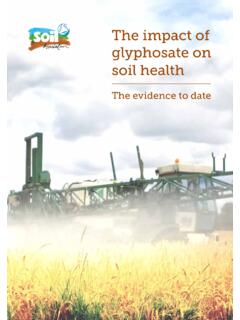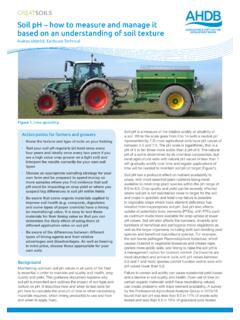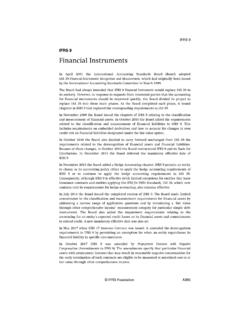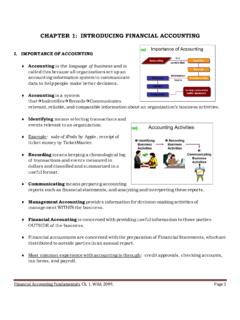Transcription of THE AGROFORESTRY HANDBOOK - Soil Association
1 THEAGROFORESTRY HANDBOOKA groforestry for the UKThe AGROFORESTRY HANDBOOK : AGROFORESTRY for the UK 1st Edition (July 2019) is licensed under the Creative Commons Attribution-NonCommercial-ShareAlike International License. To view a copy of this license visit and charts are copyrighted as by:Soil Association Limited, Spear House, 51 Victoria Street, Bristol BS1 6 ADThe Soil Association is a charity registered in England and Wales number 206862 and in Scotland number Studies by the Woodland Woodland Trust is a charity registered in England and Wales number 294344 and in Scotland number cover illustration: Andrew EvansDesign and layout: : 978-1-904665-07-6 Edited byBen Raskin and Simone Osborn1st Edition (July 2019)THEAGROFORESTRY HANDBOOKA groforestry for the UKHow to use this publicationThe contents page is hyperlinked, select title to jump to hyperlinks within the text include: urls, specific chapters/pages and PDF is best viewed in Adobe Acrobat Reader.
2 DisclaimerThe information provided within this HANDBOOK is for general informational purposes only. While the authors and publishers have made every effort to ensure that the information in this book was correct at the time of publication, there are no representations or warranties, express or implied, about the completeness, accuracy, reliability, suitability or availability with respect to the information, products, services, or related graphics contained in this HANDBOOK for any purpose. Any use of this information is at your own principles behind AGROFORESTRY are not new, they have been practised for as long as humans have been farming. Realising the full potential of integrating commercially managed trees into farming systems is, however, still a long way off. This book introduces the theory of AGROFORESTRY .
3 We look at practical management and design considerations. Where the information is available we have provided information on markets and pricing. There are countless opportunities to grow a range of tree crops for human and animal consumption, for animal welfare and soil health, for building, and even woody products to replace plastics. The potential benefits are clear both to individual farms and to the wider environment, for instance by sequestering carbon and reducing flood AGROFORESTRY journey is just beginning. A few pioneering farmers are planting commercial systems, and some are already seeing concrete commercial and environmental benefits, but trees grow slowly and we will learn more as these systems authors are leading researchers and practitioners with decades of experience in AGROFORESTRY from around the world, including research here in the UK.
4 We hope this HANDBOOK will give farmers and advisors the confidence and inspiration to start planting. The Soil Association and the Woodland Trust are delighted to be able to support the Farm Woodland Forum who are the leading UK AGROFORESTRY body. Join them for further information and support on all things AGROFORESTRY . Helen Chesshire - The Woodland Trust, Ben Raskin - Soil 1 What is AgroforestryWhat is AGROFORESTRY ?What are the types of AGROFORESTRY ?Silvopastoral AGROFORESTRY Silvoarable agroforestryAgrosilvopastoral systemsHedgerows, shelterbelts and riparian buffer stripsForest farming, Homegardens Why AGROFORESTRY ?1011121516171818 chapter 2 AGROFORESTRY systems designIntroduction and aimsIntroduction to AGROFORESTRY designThe key elements of AGROFORESTRY designThe Purpose of your AGROFORESTRY project or interventionAdviceMeasures of successAgroecologyStarting pointsAdaptive managementLayoutPractical considerations when designing specific AGROFORESTRY systems in the UKPractical design example silvopastoralPractical design example silvoarablePractical design example walnut trialWoodland/forest systems including forest gardensHedgerow/buffer strip systemsLandscape, estates and partnershipsObservation on wildlife1920212223232728 30323536384042434343 This contents page is hyperlinked, select title to jump to 4 SilvoarableWhat is silvoarable?
5 Types of silvoarable systemsCASE STUDY: Whitehall Farm - Planting to improve economic returns Maximising the arable benefitsMaximising the value of the trees 6164697074 chapter 5 Hedges, windbreaks and riparian buffersSite selection, design and establishmentHedgesHedgerows The management cycle and planningHedgerows for woodfuelIntroducing a coppice cycle to hedgesManaging hedgerows for other productsWindbreaksWindbreaks Management for protection and productionRiparian buffersRiparian buffers Management for protection and productionCASE STUDY: Trees enhance flock health and field drainageLegal and other considerations808183848586888990919293 chapter 3 SilvopastureWhat is silvopasture?How can silvopasture benefit my farming system?Different types of silvopasture systemDesigning for livestock benefitsCASE STUDY.
6 Trees mean better businessMaximising the value of the trees4546515356578 chapter 6 The economic case for agroforestryIntroductionImplications of AGROFORESTRY design on farm economicsFinancial evaluation of agroforestryWhole farm budgeting for profit from agroforestryAgroforestry fixed costs, labour and machinery budgetingGross margin analysis of agroforestrySilvoarable gross marginsSilvohorticulture gross marginsLowland silvopasture gross marginsForecasting AGROFORESTRY outputs and costsImpact on outputs from tree and crop competitionProductive potential of AGROFORESTRY Land Equivalent RatioCash flow forecasting for agroforestryLand tenureGoverment support for agroforestryAgroforestry for carbon captureMarket opportunities Direct outputs from the tree component of AGROFORESTRY systemsMarket considerationsTree establishment.
7 Maintenance and managementTree growth rate yield and productsTree species selectionReferencesAuthorsAcknowledgemen tsUseful links95979899106108109112115118118122125 126130131132133134137139142147149150 chapter 1 The Economic Case for AgroforestryAgriculture and forestry have often been treated as separate and distinct disciplines in colleges, universities and handbooks on farm management. However on the ground, most farmers manage land that combines agricultural production with trees that stand individually or in groups too small to be classified as woodland. In 2017, the Forestry Commission1 estimated there were 742,000 hectares (ha) of trees that weren t in woodlands in Great Britain (in other words less than ha). That is about of the area of Great Britain, similar to the area of barley grown in the arable and livestock systems can produce high yields per unit area and labour, but they can also have negative environmental effects.
8 The increased uptake of AGROFORESTRY in the UK can offer productivity, mitigation of climate change, water management, biodiversity and landscape, and welfare 1 What is AGROFORESTRY ?Productivity: Providing shelter for livestock can increase daily live weight gain, and windbreaks in arable systems can reduce soil erosion. Trees can provide additional sources of on-farm revenue such as woodfuel, timber, fruit, or climate change: Trees can moderate the local climate and the additional storage of carbon (above-ground and below-ground) can contribute to national greenhouse gas management: Including trees can help slow the flow of run-off from farms thereby moderating downstream flood flows and reducing soil erosion. The deep roots of appropriately placed trees can help minimise the leaching of and landscape enhancement: Across Europe, AGROFORESTRY on farmland has been shown to significantly increase the diversity of species, and there is increasing evidence that many people favour mosaic welfare: Reduced temperature extremes and a greater variety of within-field habitats can reduce animal stress and allow more natural animal Paul Burgess, Cranfield UniversityWhat is AGROFORESTRY ?
9 A useful short definition of AGROFORESTRY is farming with trees . AGROFORESTRY includes both the integration of trees on farmland and the use of agricultural crops and livestock in woodlands. In the European Union, Article 23 of Regulation 1305/2013 defines AGROFORESTRY as land use systems in which trees are grown in combination with agriculture on the same land . A more detailed definition is that AGROFORESTRY is the practice of deliberately integrating woody vegetation (trees or shrubs) with crop and/or animal systems to benefit from the resulting ecological and economic interactions 3. Whereas mixed farming is the integration of crops and livestock, AGROFORESTRY covers the area in a triangle where trees (and shrubs) are integrated with either crops, livestock, or mixed farming (Figure 1).
10 Figure 1: AGROFORESTRY involves the integration of trees and shrubs with either crop, livestock or mixed farmingPatrick Worms at the UK 2017 AGROFORESTRY Conference developed a quote by United States Supreme Court Justice Potter Stewart, in observing that AGROFORESTRY is not easy to define but I know it when I see it . Whilst Patrick, who is the 2019 President of the European AGROFORESTRY Federation (EURAF), may be able to recognise AGROFORESTRY , it is doubtful whether many others know AGROFORESTRY when they see it .This HANDBOOK argues for a wide definition of AGROFORESTRY . In fact, we argue that much of the British landscape is actually an AGROFORESTRY landscape comprising a mosaic of trees and farming and shrubsTrees and shrubsLivestockTrees and shrubsCropsAgroforestryMixed FarmingCropsLivestockLivestockCrops10 chapter 1 What is AGROFORESTRY ?













